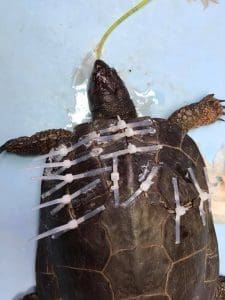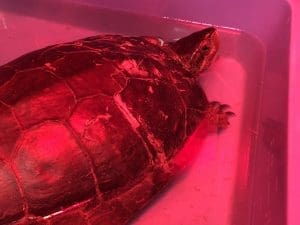 After nearly a year of care this patient was released back into the wild! The shell of this western pond turtle was badly cracked. This likely happened because the turtle was hit by a car while trying to get from his hibernation location to his home pond. There are multiple methods for turtle shell repair in rehab that range from drilling screws into a shell followed by wiring it back together to literally using duck tape. The staff at Wildlife Images has had success with super-gluing zip ties to assist with shell healing.
After nearly a year of care this patient was released back into the wild! The shell of this western pond turtle was badly cracked. This likely happened because the turtle was hit by a car while trying to get from his hibernation location to his home pond. There are multiple methods for turtle shell repair in rehab that range from drilling screws into a shell followed by wiring it back together to literally using duck tape. The staff at Wildlife Images has had success with super-gluing zip ties to assist with shell healing.
Treatment: Day 1

Shortly after arriving, in late May, we sedated Patient 18-354 and began the process of applying zip ties to his shell. The glue takes time to dry so most of the time we will apply the glue but wait to “tie” the shell together until the next day. The wound is treated similarly to any other open wound. We have to keep it as clean as possible and check it frequently to make sure it is healing well.
As most people know, turtles do not move very quickly. They have a slow metabolism and this means that they heal very slowly from injuries. If we get a turtle in with a cracked shell, we can expect to have that turtle for 6-12 months or sometimes even longer.

Keeping a turtle warm helps speed the healing process so we often keep them in an incubator or in slightly warmer conditions than what they would find in the wild. They take such a long time to heal that sometimes, we won’t know if the treatment is going to work until months into the process.
Treatment: Day 314
After nearly a year in care, Patient 18-354 was ready for the last step in rehabilitation. Before releasing any patient we must make sure it can survive in the wild. For a turtle this includes passing swimming and diving school. To ensure the healing process is complete the clinic staff looked for bubbles coming up from the shell as the turtle dove under water. A lack of bubbles meant this guy’s shell healed incredibly well and, on top of that, he passed his swimming/diving test! He was recently released into a quite area near Selma.

Why did the turtle cross the road?
Did you know that pond turtles are not fully aquatic? Pond turtles are known to journey up into forested areas during winter months to hibernate. Once it warms up, they migrate back towards areas with water. This seasonal migration puts turtles in situations where they have to cross roads and through yards. If you see a turtle crossing a road, if it is safe to do so, move it to the side of the road that it is headed.
If you see a turtle that has been hit or hit a turtle, call your local wildlife rehabilitator for help. Each year, Wildlife Images takes care of a few pond turtles that are hit by cars.
For more information about turtles, see https://www.oregonturtles.com/pond_turtle.html

